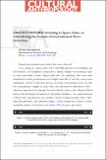Gravity’s Reverb: Listening to Space-Time, or Articulating the Sounds of Gravitational-Wave Detection
Author(s)
Helmreich, Stefan
Downloadca314A02.pdf (484.5Kb)
PUBLISHER_POLICY
Publisher Policy
Article is made available in accordance with the publisher's policy and may be subject to US copyright law. Please refer to the publisher's site for terms of use.
Terms of use
Metadata
Show full item recordAbstract
In February 2016, U.S.-based astronomers announced that they had detected gravitational waves, vibrations in the substance of space-time. When they made the detection public, they translated the signal into sound, a "chirp," a sound wave swooping up in frequency, indexing, scientists said, the collision of two black holes 1.3 billion years ago. Drawing on interviews with gravitational-wave scientists at MIT and interpreting popular representations of this cosmic audio, I ask after these scientists' acoustemology-that is, what the anthropologist of sound Steven Feld would call their "sonic way of knowing and being." Some scientists suggest that interpreting gravitational-wave sounds requires them to develop a "vocabulary," a trained judgment about how to listen to the impress of interstellar vibration on the medium of the detector. Gravitational-wave detection sounds, I argue, are thus articulations of theories with models and of models with instrumental captures of the cosmically nonhuman. Such articulations, based on mathematical and technological formalisms-Einstein's equations, interferometric observatories, and sound files-operate alongside less fully disciplined collections of acoustic, auditory, and even musical metaphors, which I call informalisms. Those informalisms then bounce back on the original articulations, leading to rhetorical reverb, in which articulations-amplified through analogies, similes, and metaphors-become difficult to fully isolate from the rhetorical reflections they generate. Filtering analysis through a number of accompanying sound files, this article contributes to the anthropology of listening, positing that scientific audition often operates by listening through technologies that have been tuned to render theories and their accompanying formalisms both materially explicit and interpretively resonant.
Date issued
2016-11Department
Massachusetts Institute of Technology. Anthropology Program; Massachusetts Institute of Technology. School of Humanities, Arts, and Social SciencesJournal
Cultural Anthropology
Publisher
Society for Cultural Anthropology
Citation
Helmreich, Stefan. “Gravity’s Reverb: Listening to Space-Time, or Articulating the Sounds of Gravitational-Wave Detection.” Cultural Anthropology 31, no. 4 (November 15, 2016): 464–492. © 2016 Society for Cultural Anthropology
Version: Final published version
ISSN
0886-7356
1548-1360